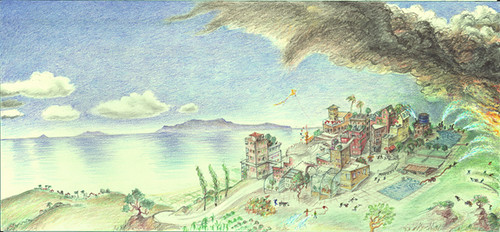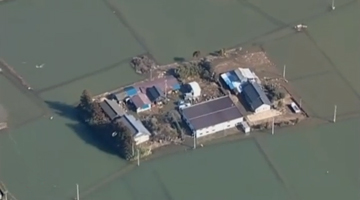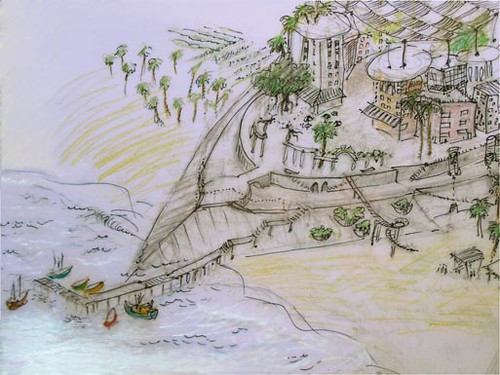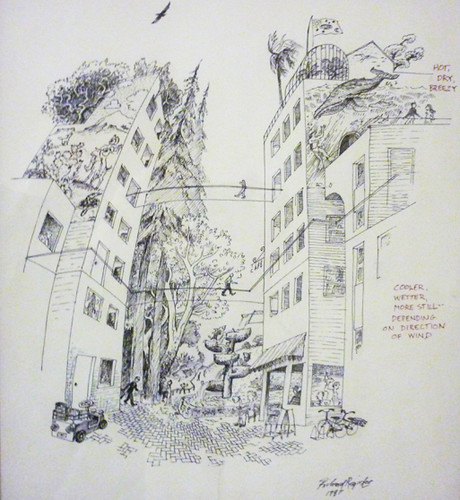Let’s face it: The way our modern oh-so-advanced society is using energy is like pouring water into a bucket with holes in it. The whole fight about which energy source is the meanest, leanest and cleanest is like we’re all standing around that bucket with our big hoses, shooting more water at the rapidly draining vortex, and the more freaked out we get because nothing seems to stop the leak, the more we point those hoses at each other, out of frustration. Meanwhile, the floor is soaking wet, the whole building is getting moldy, and we’re all catching pneumonia.
The question thus arises: What if we started putting just a bit more of our passion, ideas and ingenuity into fixing the bucket?
That is exactly what Richard Register, ecocity pioneer, visionary artist, and founder and President of Ecocity Builders, has been doing for nearly 40 years. Rather than using that big homo sapiens noggin to figure out new ways to extract more energy out of our ailing planet to fuel endless urban sprawl and unsustainable city design, he’s been drawing up and testing out plans for reshaping our city landscapes in sync with the natural rhythms of nature.
I just got an email from him in response to the multiple disasters in Japan, under the subject line Ecocity Design for Disaster Resilient Cities. Not surprisingly, it is a comprehensive look at the root of the problem and how to make the bucket whole again, rather than dousing it with more water. In a level-headed approach it addresses how the problems ranging from nuclear accidents and disaster prevention to climate change, resource depletion and social injustice could all be solved if we stopped treating them as isolated issues and got to work on re-envisioning the places where 70% of humans reside and most of our energy and resources are wasted unnecessarily: Cities.
Richard was kind enough to let me re-post his entire email here. In the hopes that we may stop filling all our leaking buckets, here it is:
∞ ∞ ∞
ECOCITY DESIGN FOR DISASTER RESILIENT CITIES
by Richard Register

Fire resistant ecotown sketch by Richard Register
The on-going disaster in Japan should not pass without a constructive response from us, which is this: ecocity design can help prevent severe earthquake and tsunami damage and can eliminate nuclear disaster completely. Ecocity design could have helped prevent the immense scale of devastation experienced in Japan and in other areas recently hit by natural disaster, like New Orleans, Sri Lanka and Haiti to name a few. If better understood and acted upon, ecocity design can help us create cities that can withstand these kinds of large scale disasters.
Elevated fill and ecocity design
At Sendai, Japan, ecocity design on top of elevated fill would have prevented most of the tsunami’s devastation by keeping the city safely above the floodwaters’ reach. Specifically, compact development built on artificial fill and designed for minimal to zero cars would have made a tremendous difference. Compactness is key here in that the ecocity becomes much more resilient in disasters due to its shape and size (think of the performance of a very large ship in a stormy ocean compared to a little boat). Furthermore, a city of small area relative to the number of people can better afford to rise up above the anticipated worst case flood event. Conversely, the cost of raising up a vast city of sprawl on fill is just not feasible.
Sendai could shrink to 40% the land area it now covers by employing ecocity design. Similarly, the car-dominated areas of New Orleans that were catastrophically damaged in hurricane Katrina could likely shrink down to 15% the current land area to become somewhat more dense and much more interestingly designed, like a French Quarter/streetcar district.

The 2004 Indian Ocean Tsunami in Indonesia. United Nations Economic and Social Commission for Asia and the Pacific web site
Redevelopment strategies that prioritize disaster-preventing infrastructure can be easily designed if ecocity insights are understood and implemented. It has happened before. Galveston Texas rebuilt on artificial fill in 1900 after it was hit with the most deadly hurricane and flood in American history. It was rebuilt on sand pumped up from Galveston Bay. Buildings that survived the hurricane were elevated ten to twenty feet on stilts and sand was filled in underneath. The elevated fill and new or raised structures were further protected on the seaward side with a reinforced seawall. Hurricane damage there has been far from catastrophic ever since: no flooding from the ocean.
We can go back even further, 4,500 years in fact, to learn about how the first cities of any scale in human history of the Sumerian Civilization were built on elevated fill and handily survived the floods of the Tigris and Euphrates rivers.
Strangely however, we still have not picked up and acted upon these critical lessons from the past. And as the philosopher George Santayana famously remarked, “Those who cannot remember the past are condemned to repeat it.”
Both tsunamis and hurricane surge

Village like cluster of farm buildings on slightly elevated fill that survived the Sendai Tsunami of 2011, from Internet news broadcast.
In areas of hurricane surge, mounding up earthen fill to about twenty feet for lowest street level – streets for streetcars and bicycles, not cars – would likely be sufficient. Where tsunamis are concerned, more like thirty-five feet would make sense. In both cases, an armored seawall, a hard surface against the waves, is needed. If planning ahead for climate change/sea rise if we don’t solve the climate crisis in time, add five or ten feet more for a hundred years extra insurance. The form of the new elevated ecocity structure counts too, with a prow toward the sea, like a ship but not quite so pointed. Imagine a 60 degree angle breakwater facing the sea and behind it the major buildings of the major districts of the city. Several such “clusters” of highly mixed use pedestrian, bicycle and transit infrastructure, several elevated districts, could be built like an archipelago of several artificial islands around the ports, and where the city backs up to the hills as in Sendai, the developed areas would blend up into the hills some distance.

Town on 35 feet of elevated fill - tsunami split as by a ship's bow, nobody hurt, building and public space - save light infrastructure at beach level - unaffected. Illustration by Richard Register
Employing ecocity design principles, very flat areas like New Orleans would be transformed over a number of decades into several elevated islands linked by transit and bicycle bridges and two lane roads, the roads mainly for various maintenance and supply functions. Come the storms and tsunamis, the buildings and people would be high and dry. Port facilities for boats and smaller ships would be destroyed in tsunamis, though ships and boats with enough warning could flea out into deeper waters with the tsunami rise and fall passing harmlessly underneath. People’s lives and major city and town infrastructure would be secure. This is something very much worth designing, planning and building for.
Earthquake safety
As far as earthquake safety, Japan’s standards are already high. Here the ecocity solution augments good development by emphasizing the larger, higher density, mixed use building that serves more people for the amount of land utilized, building materials, transportation infrastructure, heating and cooling of structures and so on. One of the novel features of ecocities – larger buildings linked by bridges between terraces and rooftops – not only supports average higher residential and working population higher above floods but the bridges can be designed to act as shock absorbers to minimize sway. As with using elevated fill, the economies of many people close together sharing financial resources provides an opportunity to simply build stronger and more flexibly; that is, with base isolation construction of larger buildings and other means of dampening the blow of earthquakes.

Buildings linked by bridges between terraces and rooftops. Illustration by Richard Register
Nuclear? What nuclear?
As to the nuclear problem, the ecocity would solve much of it by radically reducing demand for energy in the first place. Heating and cooling energy is saved by sharing walls and by thermal inertia in the larger buildings. Transport energy is saved by transit and many more people able to use walking and bicycling because the distances they need to cover are much shorter than in the automobile city. Cars would be replaced by streetcars and larger rail metros and the cross-country electrified service that is already excellent and famous in Japan. Biofuels are a bad deal in competition with food and the last of the world’s biodiverse forests, but if used very sparingly, if populations were not overwhelmingly large – and Japan is learning to live prosperously with population stability and even slightly shrinking numbers – biofuels and the last of natural gas could be gradually parsed out to fill in for times when solar and wind are not on line.
Only if we have radical energy conservation could this work – and ecocities are the means to the most progress in that direction. With a clear pattern of priorities based largely on ecocity development, who needs nuclear at all?
Why no debate on ecocities at a time like this?
To date, people are not discussing ecocity-like design as an option. We need to change this situation. Change sometimes does happen very rapidly in the world of city design and direction of growth, as Jaime Lerner, the genius of Curitiba, Brazil’s ecocity transformations in the 1970s and 1980s reminds us. “Profound changes can happen in as little as two years,” says he. And if you’ve ever been to any of the stillborn suburban sprawl developments that recently froze up nationwide, but especially in the California Central Valley, Nevada, Arizona and south Florida, you might see the possibility of reversing rather quickly the mania for ever more scattered single family development, massive and impersonal big box stores, scattered back office “campuses” and industrial “parks” and lonely very long commutes. Change can actually be swift in the city development/de-development world.
Endgame mind block or breakthrough?
When it comes to ecocities, the set of solutions that orbit around the concept of ecocity design are so many that the whole solar system of it all is often missed. Can design actually solve problems like tsunamis, and earthquakes, and nuclear accidents all in one stroke? Indeed it can. But you have to actually think about it for a few minutes to grasp that rather important insight. Can the same solution put an end to most carnage on the highways, provide open space for agriculture close to where we live and stop the paving of farm land? Can the same solution bring nature into cities for the enjoyment of all and education of the children by way of creek and ridgeline restoration, and provide beautiful views accessible to everyone in the city of the city itself and its natural location? Simple answer: yes.
– Richard Register, President, Ecocity Builders








Thank you for keeping eco-city design on your front burner. I like to think that Richard Register is going to find himself busier in these coming months and years.
Let’s hope you’re right Pam. All it’ll take is just a little bit of a shift in our thinking. It’s no rocket science, certainly less complicated than safe nuclear fission.
What a great, informative read, Sven! Thank you for adding to my understanding of all this!
Thanks for stopping by, Barb, can’t wait to chat about New Orleans, Gloria Steinem and nuclear power next month! : )
Thanks, Sven. We seriously need to rethink our entire attitude towards needs versus wants. The problem is not just nuclear disasters but our addiction to foreign oil leading to other sorts of disasters.
Yes, it’s like an ecosystem of problems, and the solutions I think have to be found through integrative thinking.
Already as child I was painting new forms of houses and communal interactive structures.In reality, I never betrayed the child I was, and went on developing ideas towards a more social and ecological society .
It has been traumatic to me, to see decades ago, so many who got tempted into the greed decadence, and it make me sad that it needs so many catastrophes easy to predict since long, to wake up the minds.
I only hope the changes are not superficial, and end in a pseudo ecology providing new markets for old disastrous structures.
agreed 100%, antiphonsgarden. One of the biggest challenges is to make changes on a deeper level and not just paying lip service to changes that don’t really change the underlying dynamics of how we do things.
The difference seems to be between those who projects their old greed aspiration on a new economy , and those who want truly a new society.